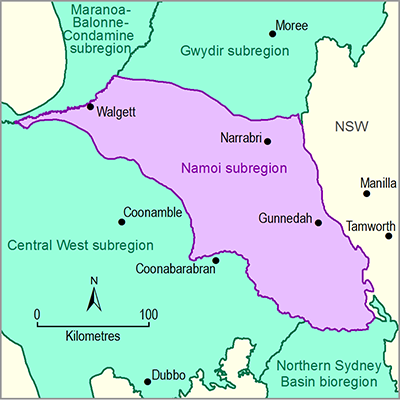The Gunnedah Basin has approximately 4% of the 2P (proved and probable) CSG reserves in Australia, approximately 1520 PJ (Geoscience Australia and BREE, 2012).
Stewart and Alder (1995) regarded the Black Jack Group as the prime target for CSG extraction in the Gunnedah Basin, as it hosts numerous seams with net coal thicknesses varying between 50 and 60 m. The Hoskissons Coal is particularly well developed in the south-east and thicker coals associated with thickening of the Black Jack Group are adjacent to the Hunter-Mooki Thrust Fault System. With non-anomalous vitrinite reflectance values ranging between 0.5 and 0.7% in the basin, significant thermogenic gas generation has likely taken place. In local zones where intrusions have heated the coal measures, vitrinite reflectance values of up to 1.3% have been measured. Stewart and Alder (1995) therefore recognised the need to further investigate the extent and influence of increased maturation on the gas generation potential of the Gunnedah Basin coals. Scott and Hamilton (2008) undertook a preliminary desktop study to identify potential CSG exploration targets. Two areas were identified in the Namoi subregion, one in the Maules Creek sub-basin and the other in the Mullaley sub-basin, coincident with existing coal mining and CSG exploration.
Decker (1999) reported mean gas contents of 14.8 m3/t (raw basis) for coals in the northern part of the basin, with raw gas contents for the Black Jack Group coals of around 9.1 m3/t. In the south, Milligan and Bunny (1996), Bunny and Milligan (1997), and also confidential company reports, as cited in Gurba and Weber (2001), reported raw gas contents of 8.9 m3/t for the Black Jack Group coals.
Gurba and Weber (2001) postulated that igneous intrusions in the Gunnedah Basin have had beneficial effects on CSG potential, assisting with gas generation and acting as impermeable seals. The study stressed the need to recognise additional sources of gas beyond those generated initially during coalification to achieve high gas content following basin uplift and cooling. The study found that gas contents within the thermal aureoles of heat-affected coal seams were substantially higher above and below the sills compared to unaffected coal seams, ranging from 6 to 7 m3/t (dry, ash-free) for the unaffected coal seams to 10 to 15 m3/t (dry, ash-free) in heat-affected coals. The intrusions had little effect on the gas composition with the gas in both affected and unaffected coals consisting of 95% methane. Mechanisms of gas generation and accumulation in the Gunnedah Basin thus include:
- local or regional enhancement of secondary thermogenic gas due to heat from igneous intrusions
- generation of secondary biogenic gases or by diffusion
- migration over long distances (Gurba, 2012).
In a study of the carbon dioxide sequestration potential of the Gunnedah Basin, Gurba et al. (2009) reported gas contents between approximately 4 and 7 m3/t for the Hoskissons Coal, between approximately 4 and 9 m3/t for the Maules Creek Formation, and between approximately 11 and 19 m3/t for the Bohena Seam. The composition of these gases varies from around 60% methane to up to 98% carbon dioxide. According to Gurba et al. (2009), gas content and composition in the Gunnedah Basin are unpredictable with composition varying both laterally and vertically within the coal measures.

Product Finalisation date
- 1.2.1 Available coal and coal seam gas resources
- 1.2.2 Current activity and tenements
- 1.2.3 Proposals and exploration
- 1.2.4 Catalogue of potential resource developments
- Citation
- Acknowledgements
- Contributors to the Technical Programme
- About this technical product
